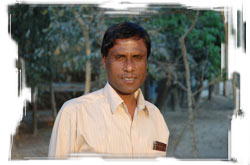Bangladesh
April 28, 2006

Nurul Islam of the NGO
Unnayan Sangha. “We were amazed when they came in
carrying two kilos of sweets and a pile of cash.” |
CIMMYT E-News, vol 3 no.
4, April 2006
Nurul Islam could hardly believe his eyes. Eleven resource-poor
farmers had just entered his office in Sherpur, Bangladesh,
carrying two kilos of sweets and a pile of cash. “We were amazed
when they came in with the sweets and money,” says Islam. “We
thought we were taking a very big risk when we made the loans,
but they paid back on-time, with interest and gave us the sweets
to express their appreciation.” Nurul Islam is a Director of
Unnayan Sangha, a non-government organization founded in 1980 to
help the region’s poor, mostly through micro-credit schemes. The
group had been very active in promoting backyard fish farms and
had been extremely successful with 6,000 working fish-ponds on
members’ land. They had not, however, thought about maize and
the income it might bring to help lift members out of poverty.
The government of
Bangladesh has tried to promote maize in the area. It is
well-suited to the climate, the availability of water, and
farmers’ needs, but most attempts had not worked well.
Nevertheless, farmers in the region are growing less and less
wheat as a second crop after rice, because the popular wheat
variety is susceptible to leaf blight, a regionally common
disease that can cut yields more than 15%. CIMMYT, with support
from the United States Agency for International Development
(USAID), has been working with the Bangladesh Agricultural
Research Institute (BARI) to study the potential of maize in the
region, particularly for animal feed.

Resource-poor farmers tend
the maize seed plot. The investment is worth it. |
Maize’s first foothold becomes a large
footprint
The beginnings of
a mini-maize revolution in Jamalpur and Sherpur began with a
single farmer, Mahbubur Rahman, who is also a mechanic. He
approached CIMMYT partner, Mahfuzul Hoque, of BARI. Hoque had
grown up in the area and understood the soil and the climate.
Rahamn asked if his land was suitable for maize as a second
crop. The answer from Hoque was a resounding ‘yes.’ Rahman
realized that in order for farmers like him to adopt maize they
would need shellers. He got the plans and manufactured one power
sheller and 48 hand shellers. He also enlisted his younger
brother Masudur and another farmer to promote the technology.
Soon the group had grown to 16 families and planted 5.5 hectares
the first season.
It was members of
that group who approached Unnayan Sangha for the loan to get
started. They were successful and soon the technology and the
crop spread. There was little maize seed available locally and
imported seed was often of low quality. Leaders of the NGO
realized there was a market for quality hybrid maize seed, and
so began community-based production of hybrid seed using two
CIMMYT maize lines (CML 283 F and CML 287 M) as parent material.
This is their first season and they intend to sell the seed from
their half hectare to small-scale farmers who are members of
their organization. Some of these farmers give their time and
labor to manage the seed plot.

M Kazal in his roadside
tea stand. “I feel
better as a landowner.” |
Half a Hectare: a Full First Step Out of
Poverty
M Kazal, one of
the first sixteen maize producers, was a landless sharecropper.
He paid the landowner with about 12% of his harvest. He also had
a roadside tea stand near his land on a dusty road in the
Sherpur district of Bangladesh. The tea stand made a little
money: enough to buy fertilizer for the land he rented.
He, his wife, and
two children attended a CIMMYT-sponsored, whole-family-training
event on maize production. He sowed little maize the first
season, but netted about US$ 175 from his harvest—enough to buy
six calves. He fed them maize the following season to fatten
them and sold them for US$ 900, earning an additional US$ 600 on
the rest of his maize. With the combined profit he decided to
make the biggest move of his life: the purchase of a half
hectare of land. In two seasons of maize growing he had gone
from landless to landowner. “I feel better as a landowner,” he
says. “My status in the community has changed.”

Kazal’s father is proud of
his son’s achievement
“I find it hard to find the words.” |
Kazal says his
first hope is to provide his children the education he never
had. His father, sitting beside him in the tea stall, grins with
pride. “I find it hard to find the words… I want him to
improve.”
Food or Feed?
Any maize in
Bangladesh will easily sell as animal feed, but Unnayan Sangha
staff are also interested in meeting human consumption needs.
They say that 20-25% of their maize farmers are now using maize
meal to make chapatti, the standard flat bread in south Asia.
Has maize
made a difference in the region? “Definitely ‘yes’,” says Hoque.
“Farmers who grow maize now have greater purchasing power and
you can see more tin sheds, more new machinery.” And to think—it
all began with two kilos of sweets to celebrate success.
For more information contact
Steve Waddington |